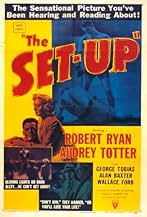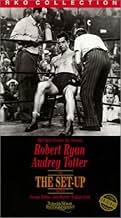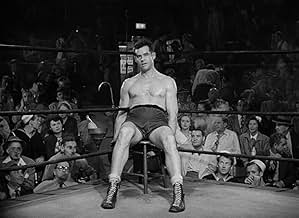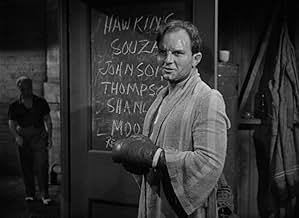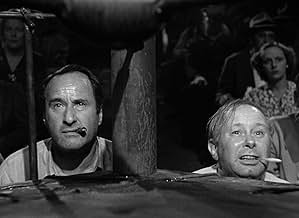CALIFICACIÓN DE IMDb
7.8/10
11 k
TU CALIFICACIÓN
Bill Thompson suele perder la lucha. Sin decírselo, su corrupto manager acepta sobornos de mafiosos pidiendo que Thompson se deje ganar en el próximo enfrentamiento.Bill Thompson suele perder la lucha. Sin decírselo, su corrupto manager acepta sobornos de mafiosos pidiendo que Thompson se deje ganar en el próximo enfrentamiento.Bill Thompson suele perder la lucha. Sin decírselo, su corrupto manager acepta sobornos de mafiosos pidiendo que Thompson se deje ganar en el próximo enfrentamiento.
- Dirección
- Guionistas
- Elenco
- Nominada a1 premio BAFTA
- 2 premios ganados y 2 nominaciones en total
Hal Baylor
- Tiger Nelson
- (as Hal Fieberling)
Kevin O'Morrison
- Moore
- (as Kenny O'Morrison)
Herbert Anderson
- Husband
- (sin créditos)
Larry Anzalone
- Mexican Fighter
- (sin créditos)
Arthur Berkeley
- Cafe Patron
- (sin créditos)
Phil Bloom
- Minor Role
- (sin créditos)
Burman Bodel
- Man
- (sin créditos)
- Dirección
- Guionistas
- Todo el elenco y el equipo
- Producción, taquilla y más en IMDbPro
Opiniones destacadas
Bill "Stoker" Thompson is 34, not old perhaps but in the world of boxing that makes him an old man. Despite the protestations of his wife Julie, Stoker still believes that one more punch, one more fight will see him making it into the marquee fights and the big time rather than being on the support bill. As he waits in the dressing room full of similar hopefuls (some his age and tired, others just starting and full of big dreams) his trainer is busy making the fix with the opposition for Stoker to go down like a $10 ho and not last the distance. However, Stoker isn't told as his manager assumes that Stoker losing is a given and that the "fix" is unnecessary and easy money for them all; however with Stoker feeling this is "the one", it may not be that simple.
Although Rocky is the one that most people will throw at you when you ask them to name a great boxing movie, The Set-Up is much, much more interesting as its aspirations are empty, its sights never getting much beyond the gutter and the men merely small players in a game that never plans for them to win. The narrative is essentially about Stoker entering a fight not aware that he has already been bought to lose but the actual film is much better than this limited plot suggests. For much of the first third we are treated to an intimate look at the small time boxers whether it be the punch-drunk old timers or the youngster who believe that they will only be doing this level for one or two fights before hitting it big. This is the reality as much as we love to see the Rocky tale of the underdog getting his day in reality the underdogs of life generally remain just that underdogs. In this section of the film this is very well painted and, although the characters are not deep enough to be people they are definitely well enough written to be interesting and engaging.
The other two thirds of the film are concerned with the fight and the aftermath, with the fight taking up the majority of the second half of the film. The fight is realistic and tense throughout, I was genuinely unsure how it would go. The aftermath is short and punchy (sorry!) and is effectively dark and gritty for it. The end result is a film that is dark, low key and gripping throughout; it exists in the gutter, in the small time where all our characters seem destined to remain regardless of heart or talent. The cast deliver well, particularly the lead role from former college boxer Ryan. He is really in touch with his character and delivers convincingly in his dialogue, his boxing and his mannerisms; while in the dressing room his facial responses to other boxers show thoughts within his head and conflicting emotions that his experience and age allow him. He is the dominant figure of the film and his is a great performance. Totter is a little less refined but her emotional delivery works well in both of her main scenes with Ryan although her wandering the streets could perhaps have been trimmed a little bit. The support cast are less well written but do still play their parts well enough but it is Ryan's film and worth seeing for him alone.
Luckily he is not the only reason to see it as the film is engaging, well written, dark, gritty, tense and very enjoyable. The lower number of votes (and potentially therefore, younger viewers) is a tragic state of affairs considering the class on display in this short punchy product and I for one will be answering "The Set-Up" when asked to name a great boxing movie.
Although Rocky is the one that most people will throw at you when you ask them to name a great boxing movie, The Set-Up is much, much more interesting as its aspirations are empty, its sights never getting much beyond the gutter and the men merely small players in a game that never plans for them to win. The narrative is essentially about Stoker entering a fight not aware that he has already been bought to lose but the actual film is much better than this limited plot suggests. For much of the first third we are treated to an intimate look at the small time boxers whether it be the punch-drunk old timers or the youngster who believe that they will only be doing this level for one or two fights before hitting it big. This is the reality as much as we love to see the Rocky tale of the underdog getting his day in reality the underdogs of life generally remain just that underdogs. In this section of the film this is very well painted and, although the characters are not deep enough to be people they are definitely well enough written to be interesting and engaging.
The other two thirds of the film are concerned with the fight and the aftermath, with the fight taking up the majority of the second half of the film. The fight is realistic and tense throughout, I was genuinely unsure how it would go. The aftermath is short and punchy (sorry!) and is effectively dark and gritty for it. The end result is a film that is dark, low key and gripping throughout; it exists in the gutter, in the small time where all our characters seem destined to remain regardless of heart or talent. The cast deliver well, particularly the lead role from former college boxer Ryan. He is really in touch with his character and delivers convincingly in his dialogue, his boxing and his mannerisms; while in the dressing room his facial responses to other boxers show thoughts within his head and conflicting emotions that his experience and age allow him. He is the dominant figure of the film and his is a great performance. Totter is a little less refined but her emotional delivery works well in both of her main scenes with Ryan although her wandering the streets could perhaps have been trimmed a little bit. The support cast are less well written but do still play their parts well enough but it is Ryan's film and worth seeing for him alone.
Luckily he is not the only reason to see it as the film is engaging, well written, dark, gritty, tense and very enjoyable. The lower number of votes (and potentially therefore, younger viewers) is a tragic state of affairs considering the class on display in this short punchy product and I for one will be answering "The Set-Up" when asked to name a great boxing movie.
Overshadowed by the more heralded The Champion in 1949, I like this movie better. Maybe the grittiness of this one with its unrelentingly seedy environment and no obvious feel good outcome made it less popular at the time. After seeing it for years on cable, a most welcome sight on DVD. Certainly an Oscar caliber performance by Ryan. The direction and cinematograpy also Oscar worthy. The boxing match itself is a classic, convincingly choreographed. The whole cast down to the smallest part is uniformly fine, with many memorable faces. The sense of anxiety we feel for Stoker mixed with hope and fleeting elation makes quite a compelling story. The movie is 71 minutes and is in `real time` ****1/2 out of *****
I love Robert Ryan films. Whether playing a scum bag or a hero, his gritty and realistic performances have always impressed me. One of his better films is this boxing flick. Ryan is an old washed-up boxer who is expected to take a dive. Through much of the film, you really don't know what he will do--throw the fight or try to salvage some of his dignity. And, I gotta say that the boxing scenes are brutal and realistic--it really HURTS to watch the fight. If you like the films THE HARDER THEY FALL or REQUIEM TO A HEAVYWEIGHT, then is this movie for you! In fact, try watching all three to get a look at the less glamorous and seedy side of boxing.
Fight scenes-wise, this was "Rocky" almost 30 years before there ever was a "Rocky." It was the same kind of unrelenting (and unrealistic in that no matter how bad the beating the good guy was getting, the good guy couldn't lose) boxing action that Sylvester Stallone likes so much.
But, don't get me wrong, I liked this film. It was good stuff. 'Rocky" was drama, romance while this was film-noir.....and solid film-noir, too.
Robert Ryan, playing a 35-year-old aging rank fighter, gives it his all against an up-and-coming kid, not knowing that he supposed to take a dive. He finally finds this out (his manager didn't tell him) and by then, he was not going give up trying against his opponent.
There are so many punches thrown in this four-round bout it will make your head swim. The best part of this film, to me, was the cinematography, which was outstanding. Kudos to director Robert Wise for the photography. There are a lot of nice facial closeups in here, all of which look sharp on the recent DVD transfer.
Humor is thrown into this film-noir as we see a variety of boxing fans, from the bloodthirsty woman to a fat man always eating to another guy acting out the action while in his ringside seat. They provide some much- needed respite from the grim story. Ryan, as he usually was, is interesting to watch. The ending of the film is a tough one and, I found tough to watch at times.
Note: the film was done in "real time" - a 72-minute period in the life of the boxer Ryan portrays.
But, don't get me wrong, I liked this film. It was good stuff. 'Rocky" was drama, romance while this was film-noir.....and solid film-noir, too.
Robert Ryan, playing a 35-year-old aging rank fighter, gives it his all against an up-and-coming kid, not knowing that he supposed to take a dive. He finally finds this out (his manager didn't tell him) and by then, he was not going give up trying against his opponent.
There are so many punches thrown in this four-round bout it will make your head swim. The best part of this film, to me, was the cinematography, which was outstanding. Kudos to director Robert Wise for the photography. There are a lot of nice facial closeups in here, all of which look sharp on the recent DVD transfer.
Humor is thrown into this film-noir as we see a variety of boxing fans, from the bloodthirsty woman to a fat man always eating to another guy acting out the action while in his ringside seat. They provide some much- needed respite from the grim story. Ryan, as he usually was, is interesting to watch. The ending of the film is a tough one and, I found tough to watch at times.
Note: the film was done in "real time" - a 72-minute period in the life of the boxer Ryan portrays.
This is an awfully hard and brutal movie, produced at the end of the brief, rather high end Dore Schary regime at RKO (1946-48), just prior to Howard Hughes' purchase of the studio, which led to the company's slow, agonizing decline that forced it, or rather its new owners, to close it down ten years later. It's the story of an aging boxer, over the hill but still harboring a measure of optimism, really a sort of pride. In this tragic role Robert Ryan is superb. Tough, compassionate, deeply ethical, realistic, and yet with just enough of the dreamer in him to keep him emotionally afloat, Stoker Thompson represents the best qualities of the so-called common man. In an earlier, more heroic age, he might have been a knight; but alas we do not live in such a time, thus his personal qualities go unnoticed by all but his wife. In this role, Audrey Totter is almost as good as Ryan. Some of her scenes are unforgettable, as when she tears up the ticket to her husband's fight and throws it over the bridge into the steam of an oncoming train; or when she watches a bunch of silly teenagers "play" at boxing with a couple of performing puppets, which at first amuses her, then horrify her when she realizes her own and her husband's fate in this little "play" scene.
The film is a masterpiece of design and composition. Director Robert Wise never made a better picture than this. The movie, like High Noon, plays out in real time, and as a result has an air of urgency to it. Adapted from a poem by Joseph Moncure March, which tells essentially the same story, but with the main character a black man, Wise and scenarist Art Cohn take considerable liberties here that purists' might not care for. In the poem the setting is New York, while in the movie it's a tank town called Paradise City, a far cry from New York even if it's in fact less than a hundred miles away, upstate, or in New Jersey or Pennsylvania. The film never makes this clear. Here and there hints are dropped that the setting might be California. It doesn't matter. The Paradise City boxing arena is a place for young guys on their way up and old guys on their way down. It's a million miles from Madison Square Garden, and that's all that counts.
The film's settings are beautifully realized; and Milton Krasner's photography is no less brilliant. The central street, all blinking lights, and yet shadowy and black in odd places, is a perfect visual metaphor for the action of the film; while seldom have the denizens of a small city looked more menacing. Men in garish ties and fedoras jostle each other on the sidewalk as they pass by. They are a hard, apathetic breed, and hungry for sensation. Inside the arena we see humanity at its least admirable, as there is an undercurrent of sadism in even the most innocuous-seeming fight fans, such as a blind man ("go for his eyes!). We sense that these people come not so much to see a favorite boxer win as a hapless boxer lose.
In the center of all this is Stoker, a man with character surrounded by people who couldn't care less. As his handlers, a porcine, toothpick-chewing Percy Helton, and a thick-witted George Tobias, are superb. In a somewhat smaller role, Edwin Max, in pinstripe suit, with pencil-line mustache's, and what look like three soggy Salada tea bags under each eye, is visually perfect as a small-time something, not even hood, just a guy who runs around and does things for the big guy, played by Alan Baxter, a sort of anti-Stoker, a man without qualities who goes to great lengths to show that he has class and principles, when in fact he has neither. The man is a monster, and he doesn't even have guts. When Stoker punches him in the face he lets his goons do the dirty work.
The interior lives of the two main characters in this film suggest an affinity with the humanistic stoicism Hemingway, while the surface is closer to Weegee and Walker Evans. Overall, though, the movie is pure RKO; its courage-in-the-face-of-adversity theme suggests, almost uncannily, this odd man out among the major studios' history and future, and the best qualities of those who worked there.
The film is a masterpiece of design and composition. Director Robert Wise never made a better picture than this. The movie, like High Noon, plays out in real time, and as a result has an air of urgency to it. Adapted from a poem by Joseph Moncure March, which tells essentially the same story, but with the main character a black man, Wise and scenarist Art Cohn take considerable liberties here that purists' might not care for. In the poem the setting is New York, while in the movie it's a tank town called Paradise City, a far cry from New York even if it's in fact less than a hundred miles away, upstate, or in New Jersey or Pennsylvania. The film never makes this clear. Here and there hints are dropped that the setting might be California. It doesn't matter. The Paradise City boxing arena is a place for young guys on their way up and old guys on their way down. It's a million miles from Madison Square Garden, and that's all that counts.
The film's settings are beautifully realized; and Milton Krasner's photography is no less brilliant. The central street, all blinking lights, and yet shadowy and black in odd places, is a perfect visual metaphor for the action of the film; while seldom have the denizens of a small city looked more menacing. Men in garish ties and fedoras jostle each other on the sidewalk as they pass by. They are a hard, apathetic breed, and hungry for sensation. Inside the arena we see humanity at its least admirable, as there is an undercurrent of sadism in even the most innocuous-seeming fight fans, such as a blind man ("go for his eyes!). We sense that these people come not so much to see a favorite boxer win as a hapless boxer lose.
In the center of all this is Stoker, a man with character surrounded by people who couldn't care less. As his handlers, a porcine, toothpick-chewing Percy Helton, and a thick-witted George Tobias, are superb. In a somewhat smaller role, Edwin Max, in pinstripe suit, with pencil-line mustache's, and what look like three soggy Salada tea bags under each eye, is visually perfect as a small-time something, not even hood, just a guy who runs around and does things for the big guy, played by Alan Baxter, a sort of anti-Stoker, a man without qualities who goes to great lengths to show that he has class and principles, when in fact he has neither. The man is a monster, and he doesn't even have guts. When Stoker punches him in the face he lets his goons do the dirty work.
The interior lives of the two main characters in this film suggest an affinity with the humanistic stoicism Hemingway, while the surface is closer to Weegee and Walker Evans. Overall, though, the movie is pure RKO; its courage-in-the-face-of-adversity theme suggests, almost uncannily, this odd man out among the major studios' history and future, and the best qualities of those who worked there.
¿Sabías que…?
- TriviaThe clock on the square at the beginning shows 9:05 PM, and the same clock at the end shows 10:16 PM. The movie takes place in real time.
- ErroresAfter the big fight, when Stoker is in the locker room, he opens his locker and takes out his clothes and shoes. In two subsequent shots his shoes are back in the locker, and then in a fourth shot he removes his shoes from the locker a second time.
- ConexionesFeatured in Film Review: Robert Wise (1967)
Selecciones populares
Inicia sesión para calificar y agrega a la lista de videos para obtener recomendaciones personalizadas
- How long is The Set-Up?Con tecnología de Alexa
Detalles
- Fecha de lanzamiento
- País de origen
- Idioma
- También se conoce como
- The Set-Up
- Locaciones de filmación
- The Hill Street Tunnels at 1st, Bunker Hill, Downtown, Los Ángeles, California, Estados Unidos(Staircase over tunnel scenes, the overlook where Julie contemplates suicide as train passes. Location was the Hill Street Tunnels, including the pedestrian staircase leading to overlook. Location was just north on Hill Street from 1st Street. Erected in 1913 and demolished in 1954 to make way for Los Angeles County Courthouse and Hall of Administration.)
- Productora
- Ver más créditos de la compañía en IMDbPro
- Tiempo de ejecución1 hora 13 minutos
- Color
- Relación de aspecto
- 1.37 : 1
Contribuir a esta página
Sugiere una edición o agrega el contenido que falta

